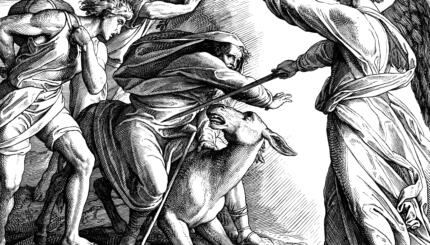Commentary on Parashat Mishpatim, Exodus 21:1 - 24:18
- Interpersonal laws ranging from the treatment of slaves to the exhibition of kindness to strangers are listed. (Exodus 21:1-23:9)
- Cultic laws follow, including the commandment to observe the Sabbatical Year, a repetition of the Sabbath injunction, the first mention of the Three Pilgrimage Festivals, rules of sacrificial offerings, and the prohibition against boiling a kid in its mother’s milk. (Exodus 23:10-19)
- The people assent to the covenant. Moses, Aaron, Nadab, Abihu, and seventy elders of Israel ascend the mountain and see God. Moses goes on alone and spends forty days on the mountain. (Exodus 24:1-18)
Focal Point
Then Moses and Aaron, Nadab and Abihu, and seventy elders of Israel ascended; and they saw the God of Israel: Under God’s feet there was the likeness of a pavement of sapphire, like the very sky for purity. Yet God did not raise God’s hand against the leaders of the Israelites; they beheld God, and they ate and drank.” (Exodus 24:9-11)
Your Guide
Compare the verses “And they saw the God of Israel” (Exodus 24:10) with “God said, ‘You cannot see My face.'” (Exodus 33:20) What aspect of God do you think they saw?
Read the following verses as a compressed narrative: “For man may not see Me and live.” (Exodus 33:20); “And they saw the God of Israel.” (Exodus 24:10); “Yet God did not raise God’s hand against the leaders of the Israelites.” (Exodus 24:11); and “They beheld God, and they ate and drank.” (Exodus 24:11) Do you think that they actually did see God and live?
Today we continue to accept that anthropomorphic images of God are meant as metaphors. What are some of the opportunities we have today to see God and live? How do we reconcile these with the teaching that we cannot see God and live?
Although 74 people presumably could agree on seeing the pavement below God, they did not have a consensus on what it was like to behold God. Therefore, the pavement was included in the text, but what they saw of God was not. Consider a moment when you believe you “saw God” (literally or metaphorically). How was your vision unique? Did the experience leave you feeling grateful for life or awed that you had survived?
By the Way…
“They saw the God of Israel.” They gazed and cast a glance [at God], and therefore they deserved death. However, God didn’t want to mar the rejoicing of the receiving of the Torah, so God waited to carry out the death penalty for Nadab and Abihu until the dedication of the Tabernacle (Leviticus 10:1-2). As for the elders, God waited until the incident mentioned in the verse “The people took to complaining bitterly before Adonai. Adonai heard and was incensed: A fire of Adonai broke out against them, ravaging the outskirts (bik’tzeh) of the camp” (Numbers 11:1), meaning the elders (bak’tzinim) that were in the camp. [The term bik’tzeh hamachaneh (“the outskirts of the camp”) is interpreted as “among the officers who were in the camp,” that is, the elders.] (Rashi on Exodus 24:10)
Abraham Ibn Ezra explained: They [the seventy-four] saw God in a prophetic vision, as did the prophets Amos in Amos 9:1 and Ezekiel in Ezekiel 1:26. (Nachmanides, quoting Ibn Ezra on Exodus 24:10)
They saw the Kavod of the God of Israel. [This Kavod is the seat of God’s glory or God’s throne.] (Saadiah Gaon)
All this refers to intellectual apprehension and in no way to the eye’s seeing. (Maimonides, The Guide of the Perplexed, I:4)
Bless Thee, O Lord, for the living arc of the sky over me this morning./Bless Thee, O Lord, for the companionship of night mist far above the skyscraper peaks I saw when I woke once during the night./Bless Thee, O Lord, for the miracle of light to my eyes and the mystery of it ever changing./Bless Thee, O Lord, for the laws Thou hast ordained holding fast these tall oblongs of stone and steel, holding fast the planet Earth in its course and farther beyond the cycle of the sun. (Carl Sandburg, “Glass House Canticle” in Harvest Poems, Harcourt, Brace & World, 1960)
If you are in search of the place/of the soul, you are the soul./If you are in search of a morsel/of bread, you are the bread./If you know this secret,/ then you know/that whatever you seek, you are that. (Rumi, a thirteenth-century Persian mystic, quoted in The Power of Prayer around the World, edited by Glenn Mosley and Joanna Hill, Templeton Foundation Press, 2000)
Your Guide
Rashi agrees with the p’shat (most literal) reading of the text: They saw God and therefore died. What is the symbolic difference between seeing God’s Kavod (Saadiah Gaon) and the actual Godhead (Rashi)?
Carl Sandburg notes the ways in which God’s presence can be seen in unexpected places on earth. We strive to recognize the Divine in the world and see God’s glory around us but often overlook God’s presence in our cities and industrial centers. Where do you tend to overlook God’s presence?
If God is not corporeal or contained in a single being, how is seeing the manifestation of God’s work distinct from actually seeing God? Do you agree that human beings “may not see [God] and live”? What aspects of your own life do you think about in connection with this warning?
The poem by Rumi suggests that we can only find that which is already a part of us. Can one who professes to be an agnostic witness the God of Judaism? Must one already believe in God in order to see the Divine?
How can recognizing each manifestation of God in the world change a person’s life?
D’var Torah
There is an inconsistency in our texts and in our general understanding of what it means to see God. On the one hand, we cannot see God and live. On the other hand, we live to see God and recognize the Divine in our loved ones, in strangers, and in the world. How can we reconcile this juxtaposition of contrary ideas?
We must make a distinction between seeing the Divine beauty of the world, a symbol of God’s glory, and the possibility of being stricken down by our audacity to look God in the face as equals.
Seeing God, looking into the eyes and soul of the Creator, understanding and knowing God as we want to know another and be known–these are not possible with God, to whom we are not equal. The seventy-four do not look directly at God but see God from below; they look up at God. The focus of their gaze is on the pavement under God’s throne. They are aware of seeing God, but the center of their attention is on the path that leads to the Eternal. By following that path, we, too, can catch a glimpse of the Eternal God.
Provided by the Union for Reform Judaism, the central body of Reform Judaism in North America.



